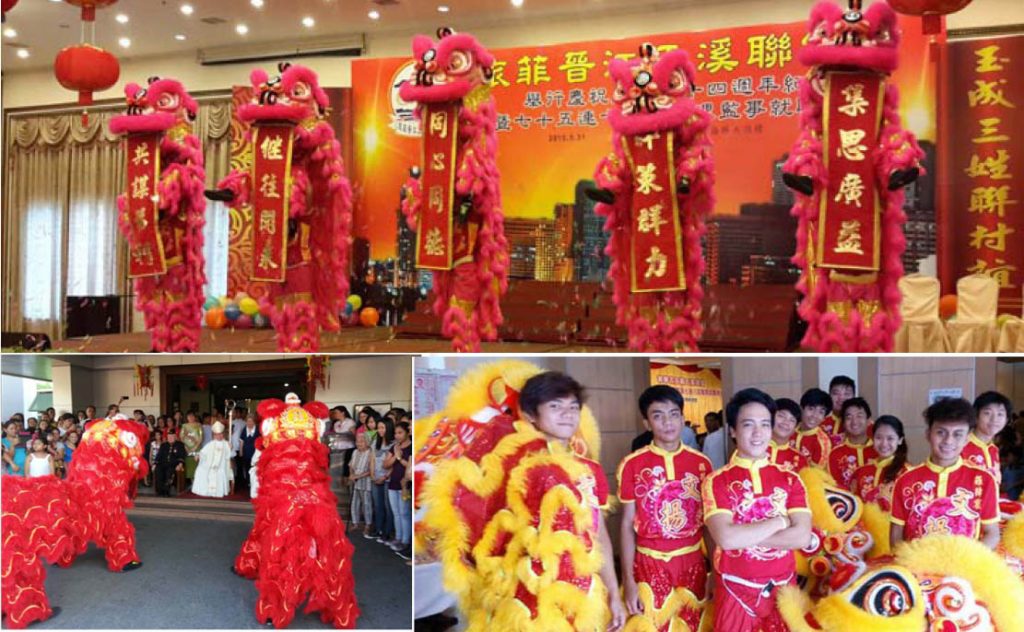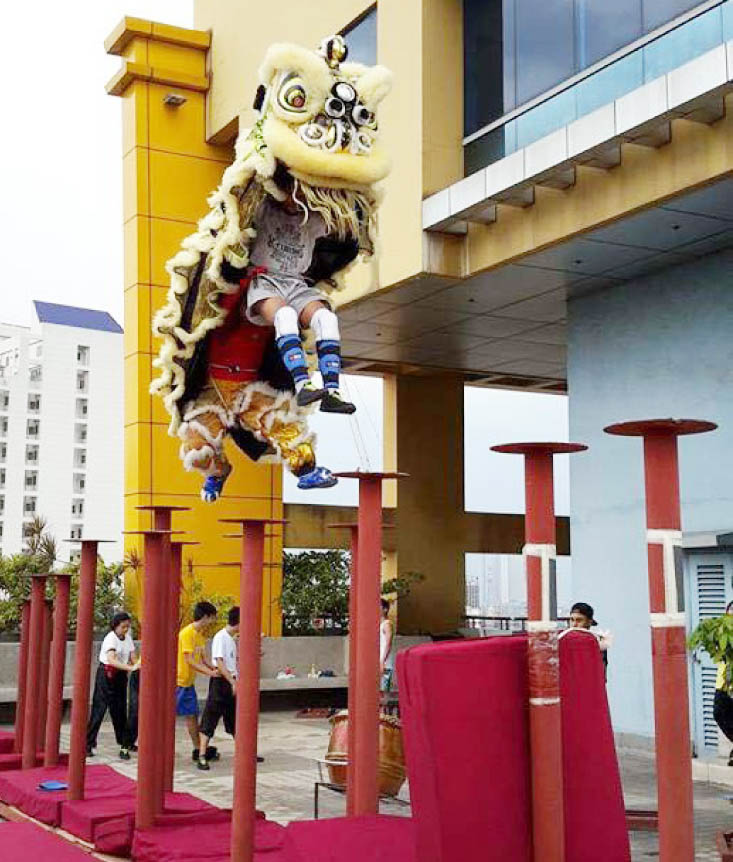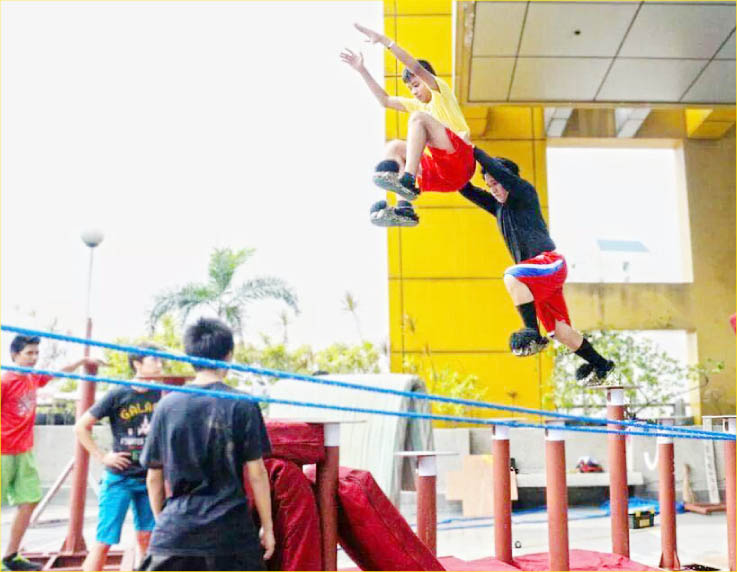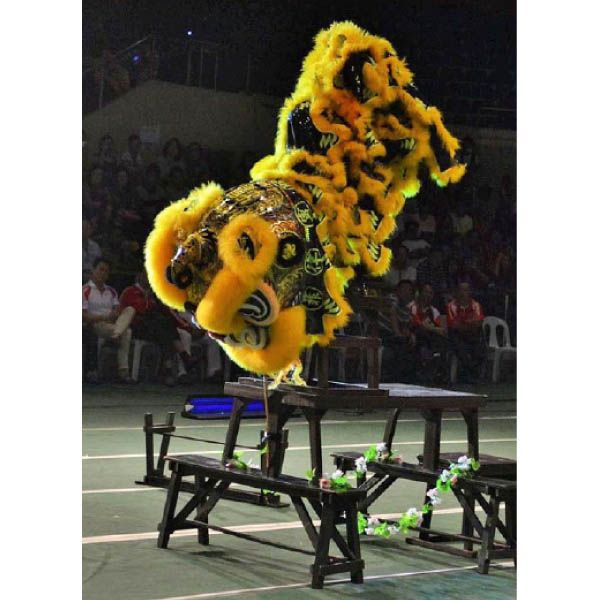First published in Tulay Fortnightly, Chinese-Filipino Digest, January 19-February 1, 2016. |
The lion dance is fast becoming an integral part of Manila’s cultural landscape. At the forefront of the revitalized lion dance scene is a new generation of Tsinoy sports associations, which uphold the values of authentic tradition, professionalism and inclusivity. In this issue, we take a closer look at the “lion dance experience” of one such organization: the Philippine Mingsheng Wenyang Sports Association (菲律濱明勝文楊體育會).
Passion for lion dance
It was not lion dance – but traditional wushu – that was in the mind of Shifu Arnold Buenviaje (蔡明仁) when he first thought of establishing an independent sports association. Together with his student Manuel Sy (黄正勝), Buenviaje formally established the Mingsheng Wushu Association on Dec. 15, 2006.
Many people thought that the name Mingsheng has some symbolic meaning. It is simply a combination of the two founders’ Chinese names: Ming [Buenviaje] and Sheng [Sy]. The new association’s first training space was a gravel-and-dirt open parking lot along Florentino Torres Street in Sta. Cruz, Manila. It was not the best place to train in the martial arts. Yet, this did not prevent the school from doing well in various wushu competitions.

Barely a year after its founding, its members made waves at the First Mantis Martial Arts Competition in Hong Kong. Today, Mingsheng Wushu Association, thanks to the efforts of current chairman Mario Tan (陳德通), has a real home: a refurbished condominium unit along San Bernardo Street in Sta. Cruz, Manila. Founders and instructors are all financially independent and serve the non-profit association pro-bono. Following the Chinatown norm, Mingsheng Wushu began to accept lion dance gigs to augment meager financial resources. This was the beginning of the association’s love affair with the art of the lion dance
In Manila’s Chinatown, wushu and the lion dance are seen as allied practices. The lion dance is an art form that demands higher-order acrobatics, strength and stamina. These come quite naturally for the wushu athlete, making their performances more graceful, more powerful, and aesthetically pleasing. Excellence in lion dancing is also a reflection of a wushu school’s caliber. Outside a proper martial arts competition, the lion dance is an alternative platform through which athletic associations can showcase students’ skills, and highlight the quality of instruction being offered in their gyms.
Mingsheng Wushu Association followed the same path, and quickly developed a reputation for quality lion dance.
Brotherhood
The year 2012 was a major turning point for the association and its lion dance program. Mingsheng Wushu Association sealed a pact of brotherhood with Singapore Wenyang Sports Association, a famous lion-dance troupe headed by Shifu Jeffrey Tan (陳慶賢).
Wenyang is considered a center of excellence for the Sarping-style lion dance, forming a well-known network of brother troupes in Insular Southeast Asia and Taiwan. In recognition of this special relationship, Mingsheng Wushu Association changed its official name to Philippine Mingsheng Wenyang Sports Association.
The issue of lineage is important in Chinese martial arts and allied art forms such as the lion dance. Knowledge is passed from master to disciple in a relationship akin to that of father and son. The formal acknowledgment of discipleship and lineage brings prestige and credibility to an athletic association. The pact with Wenyang Singapore filled this lineage need.
Some of Mingsheng Wenyang’s best lion-dance students continue to receive rigid training from Shifu Tan. Thus, they share a mediated lineage or relationship with Tan’s teacher – the recognized keeper of the Sarping lion dance himself – Master Chan Siew Kee (陳紹箕).
The pact opened up opportunities for Mingsheng Wenyang’s team to train with the masters and compete internationally. Success in international competitions in China, Macau and Hong Kong affirm the program is on the right track. Other troupes from Manila and the Visayas visit Mingsheng Wenyangs’s gym to hone their craft. In the national level, Mingsheng Wenyang is recognized as one of the major lion dance troupes and can help improve the state of the performance art in the Philippines.

Authenticity
Adhering to an authentic lion dance tradition does not mean being old-fashioned or rigid. In fact, Mingsheng Wenyang belongs to the liberal side of the Chinatown spectrum. The tradition it tries to uphold is the integrity of the lion dance as an art form.
Buenviaje admits that though lion dancing is becoming more popular in the country, there is still so much room for improvement. There is so much talent to tap, as there are well-established associations that have won top prizes abroad in lion dancing. But in general, Philippine lion dancing still has a lot of catching up to do to be at par with our neighbors. Many lion dance troupes have fallen prey to unbridled improvisation and commercialism, leaving the artistic aspect of the craft underdeveloped.
This is in sharp contrast to Singapore or Malaysia, where the lion dance is considered as an intangible national heritage, and is strictly monitored to ensure quality and safety. In allowing experts such as Master Chan, Shifu Tan, and others to teach their students the lion dance, Mingsheng Wenyang is opening its doors to authentic Sarping tradition. While there is obviously room for creativity and gimmicks, they can at least assure patrons that every movement, beat and accessory adheres to a long artistic tradition.
Mingsheng Wenyang lion dancers, however, are not expected to be too technical that the performance becomes too rigid or robotic. There are cases where a performance is technically perfect but lacks “character,” there is no heart in the performance, no refined spontaneity.
Chief instructors like Buenviaje and the younger teachers can easily spot a form-conscious lion dance pair from one who is merely showing off with over-the-top movements and acrobatics. Mastery of the form comes first before going to acrobatic gimmicks. Without mastery of the basic steps, more complicated lion dance routines can be very dangerous (especially when it involves balancing on benches, chairs, tables and poles.)
Once a performer has mastered the traditional choreography, the school allows the student to let his unique personality animate the lion. In fact they have informal lion acting workshops for this. It is for this reason that Mingsheng Wenyang takes pride in the distinct “personalities” of its lions: some are naughty and hyperactive, some are dignified and regal, and some are clowns. There is an interesting balance of faithfulness to tradition and individual artistry.
Mingsheng Wenyang also keenly emphasies professionalism in the practice of lion dancing. It is, first and foremost, a noble art form and should never be treated as a mendicant performance. It is for this reason that Mingsheng Wenyang does not engage in “door-to-door” dancing in exchange for a random sum. They only perform for people who formally ask for their services.
The association has a well-developed booking procedure similar to those of performing artists like singers and musicians. And just like professional artists, the teams are expected to give their best regardless of the type of crowd, setting, or magnitude of the event. Of peculiar interest is Mingsheng Wenyang’s inclusion of “cleanliness” in its lion dance ethic. Buenviaje later revealed that lions cannot be washed like ordinary laundry, as it can be destroyed in the process. The key is to store these in a place free from dust and humidity, and to “retire” a lion immediately upon the first signs of wear and tear. Mingsheng Wenyang imports its lions from China’s Guandong province, and these are not at all cheap. This attention to cleanliness shows reverence both for the art and the patron.
Inclusivity
Just like many contemporary Tsinoy athletic associations, Mingsheng Wenyang embraces an inclusive attitude towards non-Tsinoy aspirants. For the founders, there is simply no reason to make a big fuss of one’s ethnicity. All that is needed is a sincere desire to learn, plus a willingness to embrace the rigors of training. The absence or presence of Chinese blood in a student does not affect his ability to excel in lion dancing. In fact, some of their best lion dancers are pureblooded Filipinos.
Though Mingsheng Wenyang practices a very Chinese art form, it sees itself more as a Filipino organization. Its inclusive attitude towards students without Chinese lineage, the use of Filipino as training lingua franca [together with Hokkien], the conscious use of native symbols and material culture, and its eagerness to represent the country in international competitions, all reflect the Tsinoy’s integration in Philippine society.

Of particular interest is Mingsheng Wenyang’s liberal attitude towards women’s participation in lion dance. Traditionally, women were not allowed to participate except on the sidelines as musicians or percussionists. It was only later that Buenviaje learned about the prevalent belief among the diasporic Chinese in Southeast Asia, that since women menstruate, they can pollute the positive energies the lions are supposed to bring, effectively blocking the flow of good luck.
Mingsheng Wenyang and other groups in the Philippines no longer observe this type of gender-biased perspective. In fact, the group is proud of its all-women lion dance team which is a consistent finisher in international competitions. Mingsheng Wenyang does not have any qualms in performing lion dance beyond its Tsinoy comfort zone.
Nowadays, it is not surprising for the group to receive invitations to perform the lion dance for non-Chinese events: art festivals and exhibits, basketball games, and even the most-Pinoy of barangay fiestas. Mingsheng Wenyang’s experience in this aspect is not necessarily unique. Other Chinatown sports associations [even the older ones] are now embracing inclusivity as an essential part of their club ethics.
Ten years and counting
This year, the Philippine Mingsheng Wenyang Sports Association is marking its 10th anniversary. The celebrations already kicked-off last Nov. 29 with a gala performance at the Makati Coliseum. It is a veritable gathering of prominent figures in both traditional wushu and the lion dance.
In attendance were Master Chan, his disciples, and all the Wenyang Associations of Southeast Asia and Taiwan. Their presence is an expression of support for a lion dance program that is just starting to realize its potential for greater things.
Mingsheng Wenyang’s story is like that of a mythical lion cub who is both Chinese and Filipino, traditional and modern. The cub is at home in these dual worlds, making it a healthy Tsinoy cub that will likely roar and dance his way to a brighter future.
